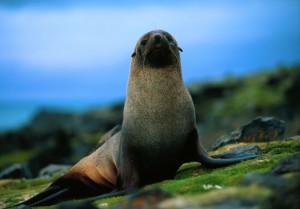
Photo credit: winkyintheuk on Flickr
Antarctic fur seals or Acrtocephalus gazella hang out in intense cold around islands in the South Atlantic and Indian Oceans near Antarctica. Simlar to other pinnipeds, Antarctic fur seals possess an intense sexual dimorphism in size between males and females. According to the Encyclopedia of Marine Mammals, males are 1.5 times longer and weigh four times as much as females.
This leads to a successful polygynous lifestyle for males who are often surrounded by nine females during breeding season. But according to the encylopedia, genetics show that females also “get around” and travel through neighboring territories to ensure they are not mating with a relative.
Male antarctic fur seals have the longest whiskers of all pinnipeds, up to 19 inches long! Maybe long whiskers help attract the ladies. Or it could be an evolutionary misfire and long hair was actually supposed to grow some place else to help males keep warm. Although they do have a lot of hair all over their bodies, just not super long. Maybe it really just is an awesome mustache.
Female antarctic fur seals have their own very cool cold weather adaptation. Because they live in a crazy cold climate, delivering their pups and breeding has to take place all during the same 10 day window. Yikes! That is true commitment to the next generations.
In order to make sure the next pup is born at exactly the same time next year, conception happens but doesn’t “take” right away. Jaume Forcada and Iain Staniland, authors of the encyclopedia article, explain that the early stage fetus, called a blastocyst, isn’t implanted into the uterus until three to four months later. This delay is referred to as a diapause period. Like humans, gestation takes about eight to nine months, so this delay allows Antarctic fur seals to have perfect timing for the warm weather window. So practical and conveinent.
Alas, the Antarctic fur seal is another species we, the people of the earth, almost managed to wipe out.
In fact it seems we actually made a concerted effort to do just that. According to the Encyclopedia of Marine Mammals: “Fur-sealing on South Georgia continued until just one seal was found and killed in 1915.” Can you imagine? After humans have been hunting in the Antarctic since 1775 and killing thousands upon thousands of fur seals, some guys show up in 1915 and find one poor seal left and kill it? Sounds like a really worthwhile hunting trip.
From their perspective it could have easily been the last Antarctic fur seal on earth. Did it ever cross their minds to just let it live? Or was it a mercy killing and they thought, “Might as well kill the last one, there’s no one left to mate with.” Or “We traveled all this way, darn it, we are going to kill a fur seal.” I guess we will never know. Thankfully, a few fur seals were left on another island and have recovered nicely and made it to the 21st Century.
Leave a Reply